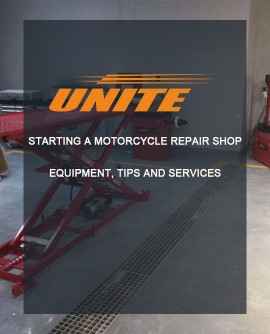
How to Starting a Motorcycle Repair Shop: Equipment, Tips and Services
13/06/2023 | Unite Automotive Equipment
Starting a motorcycle repair shop requires careful planning and consideration to ensure a successful and efficient operation. From acquiring the right equipment to offering a range of services, this guide will provide you with essential tips and insights to help you establish and run a thriving motorcycle repair shop.
- Define Your Services:
Begin by identifying the services you will offer at your motorcycle repair shop. Common services include routine maintenance, engine repairs, electrical diagnostics, tire changes, and customizations. Determine your area of expertise and tailor your services accordingly to attract a specific target market.
- Acquire Essential Equipment:
To efficiently operate a motorcycle repair shop, you will need the following equipment:
Motorcycle Lift: A hydraulic lift allows you to elevate motorcycles, making repairs and inspections more accessible.
Basic Tools: Invest in high-quality tools such as wrenches, sockets, pliers, and screwdrivers. These tools will be indispensable for various repairs and adjustments.
Diagnostic Equipment: Diagnostic tools help identify issues in the engine, electrical systems, and other components, facilitating accurate repairs.
Tire Changer and Wheel Balancer: A tire changer and balancer enable you to remove and install motorcycle tires, ensuring smooth rides and optimal safety.
Welding Equipment: Welding tools are crucial for repairs involving frames, exhaust systems, or other metal components.
Parts and Inventory Management System: Implement a system to track inventory and manage motorcycle parts efficiently.
- Create a Functional Workspace:
Organize your repair shop to optimize workflow and create a safe working environment:
Workbenches and Storage: Install sturdy workbenches for repairs and ample storage space for tools, equipment, and spare parts.
Well-Designed Layout: Arrange workstations logically, considering the flow of motorcycles and technicians, to maximize efficiency.
Safety Measures: Implement safety protocols, including fire extinguishers, ventilation systems, eye protection, and proper disposal methods for hazardous materials.
- Build a Skilled Team:
Hire qualified technicians who possess the necessary expertise and experience in motorcycle repairs. Ensure that your team stays updated with the latest industry trends and technologies through continuous training and certifications.
- Establish Supplier Relationships:
Develop partnerships with reliable suppliers to ensure a steady supply of high-quality motorcycle parts and accessories. Building strong relationships can lead to favorable pricing, prompt deliveries, and access to a wide range of products.
- Provide Excellent Customer Service:
Deliver exceptional customer service to foster loyalty and attract repeat business:
Clear Communication: Listen to customers' concerns, explain repairs in a language they understand, and provide accurate estimates and timelines.
Transparent Pricing: Clearly communicate pricing structures and billing policies to avoid any surprises.
Convenient Appointment Scheduling: Implement an efficient appointment system to manage customer flow and minimize waiting times.
Warranty and Guarantees: Offer warranties on repairs and provide guarantees for the quality of your work to instill confidence in your customers.
Conclusion:
Setting up a motorcycle repair shop requires careful planning, the right equipment, and a focus on customer service. By defining your services, acquiring essential equipment, creating a functional workspace, building a skilled team, establishing supplier relationships, and providing excellent customer service, you can lay the foundation for a successful motorcycle repair shop. Remember to stay updated with industry advancements and adapt to the changing needs of motorcycle enthusiasts to thrive in this competitive market.
